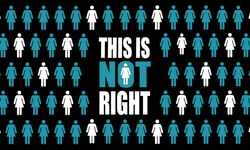Have we reached the tipping point? There are now 37.6 million internet users in the UK — nearly two-thirds of the UK population. Usage is still skewed towards the young and relatively upmarket — reflecting the heartland audience of many magazine titles. Crucially, from a publisher’s perspective, broadband now accounts for nearly 70% of all household internet connections — making the UK one of the highest ranking countries in the world for broadband access. The implications for publishers are profound, as multimedia formats become a reality. Peter Phippen, managing director of BBC Magazines picked up on this recently when he said: "we’ve been operating for years with low web speeds, which has a lot of direct comparisons with magazines — static content with pictures." Video, he says, is going to bring big changes. "It’s crucial to bring rich video content into our sites."
It is hardly surprising then, to see the results from Nielsen on display advertising for 2006. Whilst the display advertising market for magazines declined by 3.6% year on year, online grew by 25%. It’s worth noting that the only other media to grow at all last year were outdoor by 1% and radio by 0.5%! The internet now offers display advertising opportunities that combine the broadcasters’ advantages of motion and sound with potentially huge numbers of users. That’s a massive advantage. And it’s these two related factors that lay behind our decision to commission some research to understand how consumers were using the print and web versions of consumer publications and how well prepared publishers were for a change in market behaviour.
We commissioned Experian’s Canvasse Opinion to undertake research that looked at the magazines and their related internet sites of 40 of the UK’s top 100 titles. We wanted to understand the internet and magazine readership habits of a representative sample of the UK’s online population. In all, 2,850 interviews were conducted. It exposed some fascinating insights into consumer usage.
Poor penetration of the UK’s online population
The contrast between audience penetration of magazine titles and their internet equivalents is striking. When the women’s magazine market was analysed, it was clear that few magazines had started to exploit the power of their print brands in an internet format. A handful of magazines — New Woman, Woman and Home and Glamour — had websites that had audiences that approached 50% of their magazine readership. But many more websites were languishing in the doldrums with typically around 20% of the reach of their print equivalents. And, without exception, all women’s magazines websites offered less than 10% of the UK’s online population of 37 million.
Men’s magazines websites, as might be expected, fared better, with most titles having internet sites that were around 50% of their print penetration, and two — Maxim and Zoo — with around 75%. In common with women’s magazines though, not one website offered more than 10% penetration of the UK’s online population.
Should this lack of penetration surprise us? I struggle to understand how this status quo is allowed to exist given how intensely competitive the UK consumer publishing market is. It’s crying out for someone to break the deadlock. Just one piece of data should bring this issue into stark relief: MySpace UK — launched little over a year ago — has 8.7m ‘friends’ on its books. It has become the place to launch bands and entertainment brands. It’s become an advertiser’s dream.
What these publishers’ websites seem to be about is brand reinforcement, not exponential growth. Our survey would seem to bear out research, undertaken by AOP in 2006, which found that 68% of magazine website users also read the parent magazine. There is very little here to support one of the major internet strategies of all publishers over recent years: that of marketing the print brand and bringing it to a fresh, and larger, audience.
It was interesting to note the two exceptions to this rule. BBC websites gardenersworld.co.uk and goodfood.co.uk both offered a distinct contrast to this dismal picture. Both these sites enjoyed larger audiences than they do in print. In the case of Good Food, 18% of the UK online population has used this site. It was interesting to note in April that Gardeners’ World announced its intention to launch a dedicated website featuring advice-led content. This is a major shift away from the standard publisher strategy of using websites to drive subscriptions and showcase the magazine.
Missing the point of the internet
One of the purposes of our survey was to discover more about the usage habits of the UK’s online audience and discover what implications this might have for the publishing industry. It provides a fascinating insight into just how widespread some of these have become. Around 50% of the UK online population have used instant messaging, watched a video online or rated a product or service online. A third have visited a blog or used the internet to display photographs.
This data is particularly interesting when it is analysed by various demographics. Usage by age bore out much of what we expected, but other factors were less obvious. For instance, a striking picture emerged of the differences between the way men and women used the web. Men were far more application-led: the internet being accessed for personal entertainment and enjoyment. Women’s usage in contrast was far more centred around the internet’s ability to link people together. The picture here was one of using the internet to communicate and share: females were more likely than men to use instant messaging and share photographs online.
This brief example illustrates why the men’s publishing sector has seen greater usage of its websites than women’s. Too often, websites have been designed around built-in applications to boost the interest level. Yet, for nearly half of the online population this does not fit in with why the internet is used. Publishers design websites and build internet strategies in the absence of consumer understanding at their peril.
The impact of the internet on the newsstand
Behind this picture of burgeoning internet usage, a remarkably consistent and alarming picture started to emerge. A good third of the UK online population felt they were reading magazine less, as a direct result of the time they spent online.
Although this was slightly more likely to be men, 34% of women also agreed with this statement. But it was the impact that this had on magazine readership that was most startling of all. When we looked at readership of women’s magazines, it was clear that those who regularly read (3 out of every 4 issues) a magazine were relatively unaffected by this phenomenon. They, after all, are the avid readers and subscribers. Those who rarely read a magazine — less than 1 in 4 issues — were far less likely to agree to this statement about declining magazine readership: their readership was so light as to not be a factor. The segment that were uniquely affected were the occasional readers — 1 or 2 issues out of 4. And this is heartland newsstand country.
In the absence of integrated media usage data, newsstand gains and losses have most commonly been attributed to competitive and distribution upsets. Our research suggests that something more profound is also taking place.
Further light is shed when we analysed the data by attitudinal statements. One of these was the perennial ghost at the banquet: "If the magazine website was free I’d prefer to read that than buying the print version." 30% of the UK online population agreed with this. That’s equivalent to around 11m internet users across the UK. Unsurprisingly, there were strong correlations between those agreeing to this statement and also claiming they read fewer magazines as a result of the internet. Other sensitive correlations were found with those aged 18-34, single and in full-time employment.
Which really leads me back to the beginning. The internet population is young and upmarket. Broadband has achieved critical mass and display advertising is taking off fast. I for one will be following the digital launches with a great degree of interest.
FEATURE
The Internet and Newsstand: expect a showdown
2007 promises to be the year that consumer publishers get their online act together as all the main publishers announce significant plans for the internet side of their business. So exactly what do they need to do to truly integrate their publishing brands? Recent research conducted by Stingray Research, says Anthony Ray, reveals all the ingredients for a showdown between newsstand and the internet.










